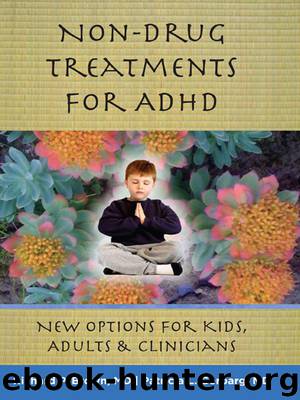Non-Drug Treatments for ADHD: New Options for Kids, Adults, and Clinicians by Richard P. Brown & Patricia L. Gerbarg

Author:Richard P. Brown & Patricia L. Gerbarg
Language: eng
Format: mobi
Tags: Psychopathology, Attention-Deficit Disorder (ADD-ADHD), Psychology
ISBN: 9780393707724
Publisher: W. W. Norton
Published: 2012-04-22T21:00:00+00:00
Q: Who is likely to benefit from SAMe?
A: SAMe can be very helpful for the following indications:
• A history of improving on prescription stimulants such as Ritalin or Adderall, but inability to tolerate the side effects.
• ADHD plus depression.
• Incomplete response to medications
• Habituation (loss of effectiveness over time) with stimulants
• Combines well with Rhodiola rosea (see Chapter 3) for synergistic benefits
• May enhance and accelerate response to biofeedback (see Chapter 6).
PICAMILON
Picamilon is a combination of two natural compounds: the B vitamin niacin and a calming neurotransmitter called gamma-aminobutyric acid (GABA). One of its main effects is to increase blood flow within the brain by decreasing cerebral blood vessel tone. When blood flow increases, brain cells receive more oxygen and nutrients. This may be why picamilon can improve cognitive function as well as alertness and decrease anxiety and depression. Although Picamilon has mild stimulative properties, it reduces aggressive behavior in animal studies. In our clinical work we find that picamilon can be very helpful not only for ADHD, but also in patients with cerebral vascular disease, stroke, traumatic brain injuries, and those recovering from a stroke. People with ADHD may have difficulties remembering appointments and keeping track of time. Some are constantly late and as a result they may lose friends who interpret their lateness as a sign of unreliability or a lack of consideration. One of Dr. Brown’s patients was always late even for very important appointments.
Judy missed her first two appointments with me [Dr. Brown]. Although she was being treated for anxiety, depression, and an eating disorder, I began to think that she might also have ADHD. I called the night before to remind her of the next appointment and she managed to come, though 15 minutes late. She apologized profusely and told me tearfully that she had lost most of her friends because she always forgot to keep the dates she made with them. “People think I don’t care about them when I forget or I’m an hour late. They accuse me of being inconsiderate, but I can’t help it. I do everything I can think of to be on time, but it just slips away from me and then, when I realize, it’s too late.”
By the age of 50, Judy had been through many different antidepressants, mood stabilizers, and major tranquilizers. In the past, Provigil, a stimulant, had been more helpful than the other drugs. She was being treated by a cognitive behavior therapist.
Judy had heard about picamilon from other patients with ADHD, and she wanted to give it a try. From the first day, starting with just 100 mg, she noticed a change. At a full dose of 200 mg in the morning and 100 mg in the afternoon, she was less scattered, much more focused and organized. She was able to think more clearly. Depression, motivation, and energy all improved markedly. She cleaned her long neglected brushes, set up an easel, and took up painting again.
How to Use Picamilon: Side Effects, Dosage, and Timing
Picamilon is very low in side effects, even when given to elderly people.
Download
This site does not store any files on its server. We only index and link to content provided by other sites. Please contact the content providers to delete copyright contents if any and email us, we'll remove relevant links or contents immediately.
Should I Stay or Should I Go? by Ramani Durvasula(7432)
Why We Sleep: Unlocking the Power of Sleep and Dreams by Matthew Walker(6362)
Fear by Osho(4496)
Flow by Mihaly Csikszentmihalyi(4493)
Rising Strong by Brene Brown(4193)
Why We Sleep by Matthew Walker(4192)
How to Change Your Mind by Michael Pollan(4115)
Too Much and Not the Mood by Durga Chew-Bose(4096)
The Hacking of the American Mind by Robert H. Lustig(4091)
Lost Connections by Johann Hari(3927)
He's Just Not That Into You by Greg Behrendt & Liz Tuccillo(3716)
Evolve Your Brain by Joe Dispenza(3506)
The Courage to Be Disliked by Ichiro Kishimi & Fumitake Koga(3261)
Crazy Is My Superpower by A.J. Mendez Brooks(3207)
What If This Were Enough? by Heather Havrilesky(3199)
Resisting Happiness by Matthew Kelly(3197)
Descartes' Error by Antonio Damasio(3167)
The Book of Human Emotions by Tiffany Watt Smith(3145)
In Cold Blood by Truman Capote(3140)
